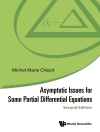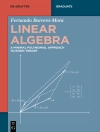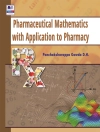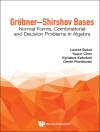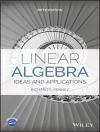A hands-on introduction to the theoretical and computational
aspects of linear algebra using Mathematica®
Many topics in linear algebra are simple, yet computationally
intensive, and computer algebra systems such as Mathematica®
are essential not only for learning to apply the concepts to
computationally challenging problems, but also for visualizing many
of the geometric aspects within this field of study. Principles of
Linear Algebra with Mathematica uniquely bridges the gap between
beginning linear algebra and computational linear algebra that is
often encountered in applied settings, and the commands required to
solve complex and computationally challenging problems using
Mathematica are provided.
The book begins with an introduction to the commands and
programming guidelines for working with Mathematica. Next, the
authors explore linear systems of equations and matrices,
applications of linear systems and matrices, determinants,
inverses, and Cramer’s rule. Basic linear algebra topics, such as
vectors, dot product, cross product, and vector projection are
explored, as well as a unique variety of more advanced topics
including rotations in space, ’rolling’ a circle along a curve, and
the TNB Frame. Subsequent chapters feature coverage of linear
transformations from Rn to Rm, the geometry of linear and affine
transformations, with an exploration of their effect on arclength,
area, and volume, least squares fits, and pseudoinverses.
Mathematica is used to enhance concepts and is seamlessly
integrated throughout the book through symbolic manipulations,
numerical computations, graphics in two and three dimensions,
animations, and programming. Each section concludes with standard
problems in addition to problems that were specifically designed to
be solved with Mathematica, allowing readers to test their
comprehension of the presented material. All related Mathematica
code is available on a corresponding website, along with solutions
to problems and additional topical resources.
Extensively class-tested to ensure an accessible presentation,
Principles of Linear Algebra with Mathematica is an excellent book
for courses on linear algebra at the undergraduate level. The book
is also an ideal reference for students and professionals who would
like to gain a further understanding of the use of Mathematica to
solve linear algebra problems.
Innehållsförteckning
Preface.
Conventions and Notations.
1. An Introduction to Mathematica.
1.1 The Very Basics.
1.2 Basic Arithmetic.
1.3 Lists and Matrices.
1.4 Expressions Versus Functions.
1.5 Plotting and Animations.
1.6 Solving Systems of Equations.
1.7 Basic Programming.
2. Linear Systems of Equations and Matrices.
2.1 Linear Systems of Equations.
2.2 Augmented Matrix of a Linear System and Row Operations.
2.3 Some Matrix Arithmetic.
3. Gauss-Jordan Elimination and Reduced Row Echelon Form.
3.1 Gauss-Jordan Elimination and rref.
3.2 Elementary Matrices.
3.3 Sensitivity of Solutions to Error in the Linear System.
4. Applications of Linear Systems and Matrices.
4.1 Applications of Linear Systems to Geometry.
4.2 Applications of Linear Systems to Curve Fitting.
4.3 Applications of Linear Systems to Economics.
4.4 Applications of Matrix Multiplication to Geometry.
4.5 An Application of Matrix Multiplication to Economics.
5. Determinants, Inverses, and Cramer’ Rule.
5.1 Determinants and Inverses from the Adjoint Formula.
5.2 Determinants by Expanding Along Any Row or Column.
5.3 Determinants Found by Triangularizing Matrices.
5.4 LU Factorization.
5.5 Inverses from rref.
5.6 Cramer’s Rule.
6. Basic Linear Algebra Topics.
6.1 Vectors.
6.2 Dot Product.
6.3 Cross Product.
6.4 A Vector Projection.
7. A Few Advanced Linear Algebra Topics.
7.1 Rotations in Space.
7.2 ’Rolling’ a Circle Along a Curve.
7.3 The TNB Frame.
8. Independence, Basis, and Dimension for Subspaces of Rn.
8.1 Subspaces of Rn.
8.2 Independent and Dependent Sets of Vectors in Rn.
8.3 Basis and Dimension for Subspaces of Rn.
8.4 Vector Projection onto a subspace of Rn.
8.5 The Gram-Schmidt Orthonormalization Process.
9. Linear Maps from Rn to Rm.
9.1 Basics About Linear Maps.
9.2 The Kernel and Image Subspaces of a Linear Map.
9.3 Composites of Two Linear Maps and Inverses.
9.4 Change of Bases for the Matrix Representation of a Linear Map.
10. The Geometry of Linear and Affine Maps.
10.1 The Effect of a Linear Map on Area and Arclength in Two Dimensions.
10.2 The Decomposition of Linear Maps into Rotations, Reflections, and Rescalings in R2.
10.3 The Effect of Linear Maps on Volume, Area, and Arclength in R3.
10.4 Rotations, Reflections, and Rescalings in Three Dimensions.
10.5 Affine Maps.
11. Least-Squares Fits and Pseudoinverses.
11.1 Pseudoinverse to a Nonsquare Matrix and Almost Solving an Overdetermined Linear System.
11.2 Fits and Pseudoinverses.
11.3 Least-Squares Fits and Pseudoinverses.
12. Eigenvalues and Eigenvectors.
12.1 What Are Eigenvalues and Eigenvectors, and Why Do We Need Them?
12.2 Summary of Definitions and Methods for Computing Eigenvalues and Eigenvectors as well as the Exponential of a Matrix.
12.3 Applications of the Diagonalizability of Square Matrices.
12.4 Solving a Square First-Order Linear System if Differential Equations.
12.5 Basic Facts About Eigenvalues, Eigenvectors, and Diagonalizability.
12.6 The Geometry of the Ellipse Using Eigenvalues and Eigenvectors.
12.7 A Mathematica Eigen Function.
Suggested Reading.
Indices.
Keyword Index.
Index of Mathematica Commands.
Om författaren
Kenneth Shiskowski, Ph D, is Professor of Mathematics at Eastern
Michigan University. His areas of research interest include
numerical analysis, history of mathematics, the integration of
technology into mathematics, differential geometry, and dynamical
systems. Dr. Shiskowski is the coauthor of Principles of Linear
Algebra with Maple, published by Wiley.
Karl Frinkle, Ph D, is Associate Professor of Mathematics at
Southeastern Oklahoma State University. His areas of research
include Bose-Einstein condensates, nonlinear optics, dynamical
systems, and integrating technology into mathematics. Dr. Frinkle
is the coauthor of Principles of Linear Algebra with Maple,
published by Wiley.







